Higher Nationals in Hospitality Management: F&B Operations Report
VerifiedAdded on 2023/01/12
|9
|1685
|24
Report
AI Summary
This report provides a comprehensive overview of food and beverage (F&B) operations. It begins by exploring various business types within the industry, such as table services and their nuances, and then delves into the use of rating systems and the impact of current and future trends in digital technology on F&B businesses. The report then examines legal requirements and regulatory standards, including HACCP and equipment cleaning, highlighting their significance in ensuring food safety. It also analyzes menu design, emphasizing its importance in attracting customers and offering customized options. Furthermore, the report discusses different operational and marketing technologies, such as CRM, and the factors influencing consumer decisions, including pricing and food variety, while also covering strategies for building customer loyalty and the effects of digital technology on the F&B sector. The conclusion summarizes the key aspects of F&B business, services, menu, and technology within the industry.
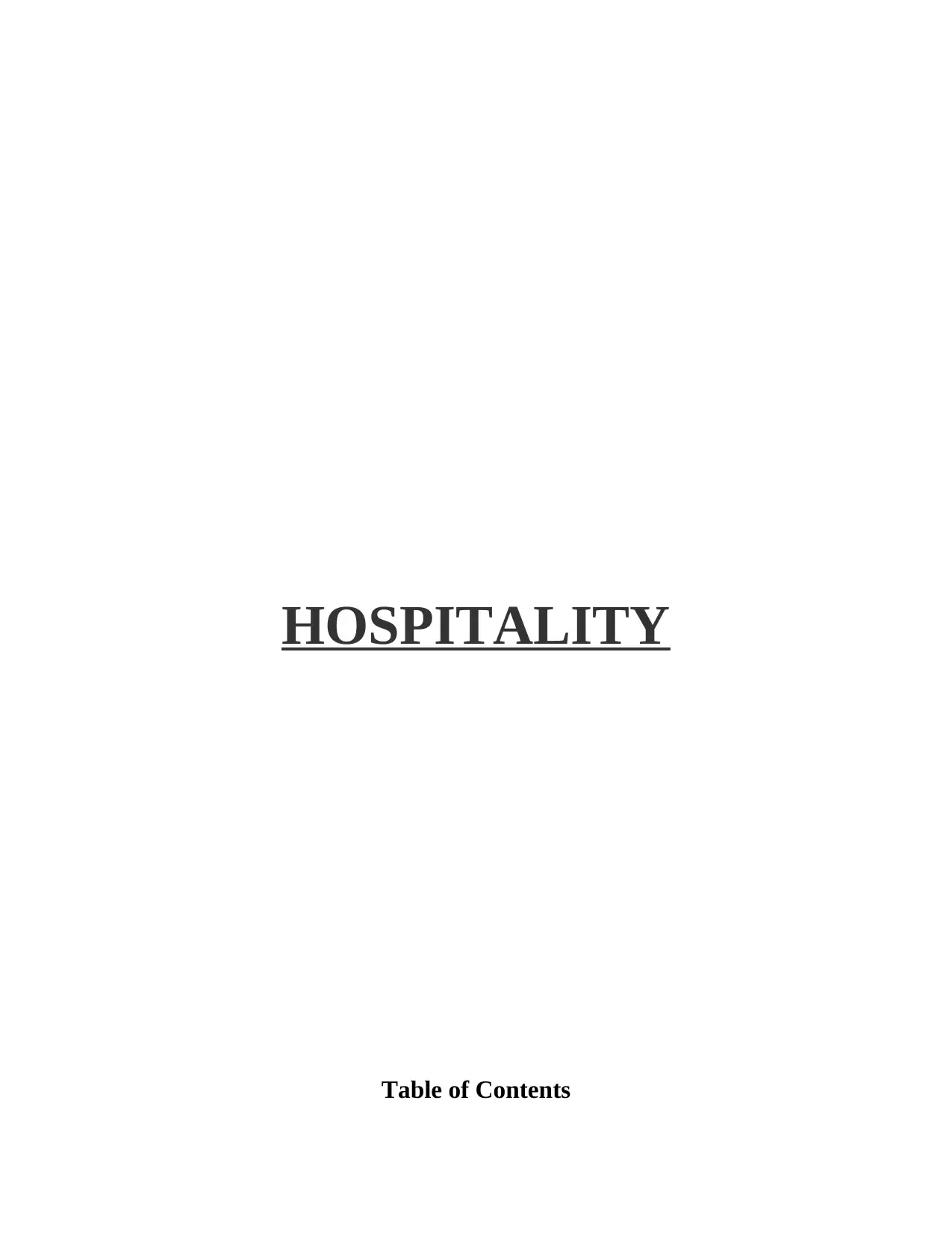
HOSPITALITY
Table of Contents
Table of Contents
Paraphrase This Document
Need a fresh take? Get an instant paraphrase of this document with our AI Paraphraser
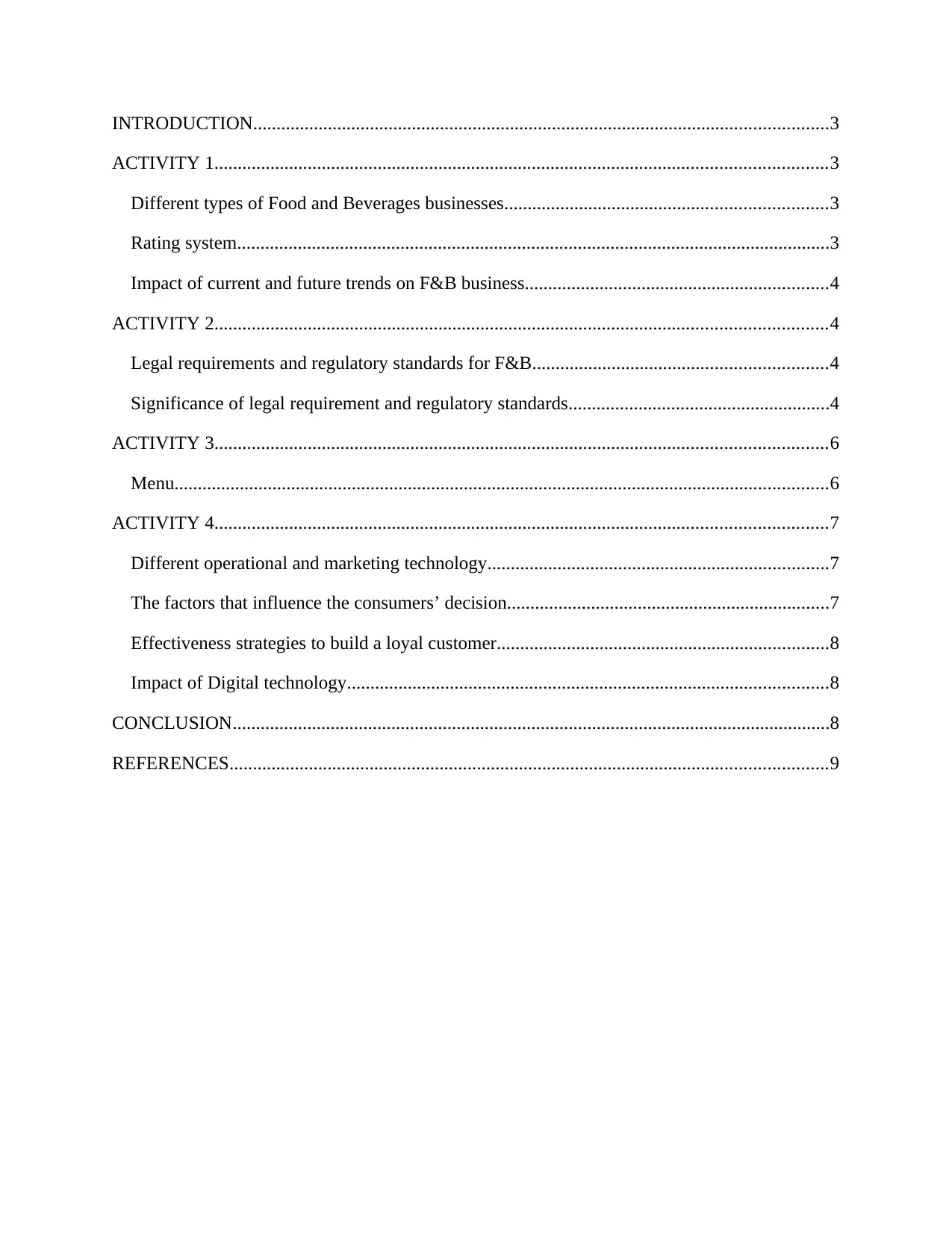
INTRODUCTION...........................................................................................................................3
ACTIVITY 1...................................................................................................................................3
Different types of Food and Beverages businesses.....................................................................3
Rating system...............................................................................................................................3
Impact of current and future trends on F&B business.................................................................4
ACTIVITY 2...................................................................................................................................4
Legal requirements and regulatory standards for F&B...............................................................4
Significance of legal requirement and regulatory standards........................................................4
ACTIVITY 3...................................................................................................................................6
Menu............................................................................................................................................6
ACTIVITY 4...................................................................................................................................7
Different operational and marketing technology.........................................................................7
The factors that influence the consumers’ decision.....................................................................7
Effectiveness strategies to build a loyal customer.......................................................................8
Impact of Digital technology.......................................................................................................8
CONCLUSION................................................................................................................................8
REFERENCES................................................................................................................................9
ACTIVITY 1...................................................................................................................................3
Different types of Food and Beverages businesses.....................................................................3
Rating system...............................................................................................................................3
Impact of current and future trends on F&B business.................................................................4
ACTIVITY 2...................................................................................................................................4
Legal requirements and regulatory standards for F&B...............................................................4
Significance of legal requirement and regulatory standards........................................................4
ACTIVITY 3...................................................................................................................................6
Menu............................................................................................................................................6
ACTIVITY 4...................................................................................................................................7
Different operational and marketing technology.........................................................................7
The factors that influence the consumers’ decision.....................................................................7
Effectiveness strategies to build a loyal customer.......................................................................8
Impact of Digital technology.......................................................................................................8
CONCLUSION................................................................................................................................8
REFERENCES................................................................................................................................9
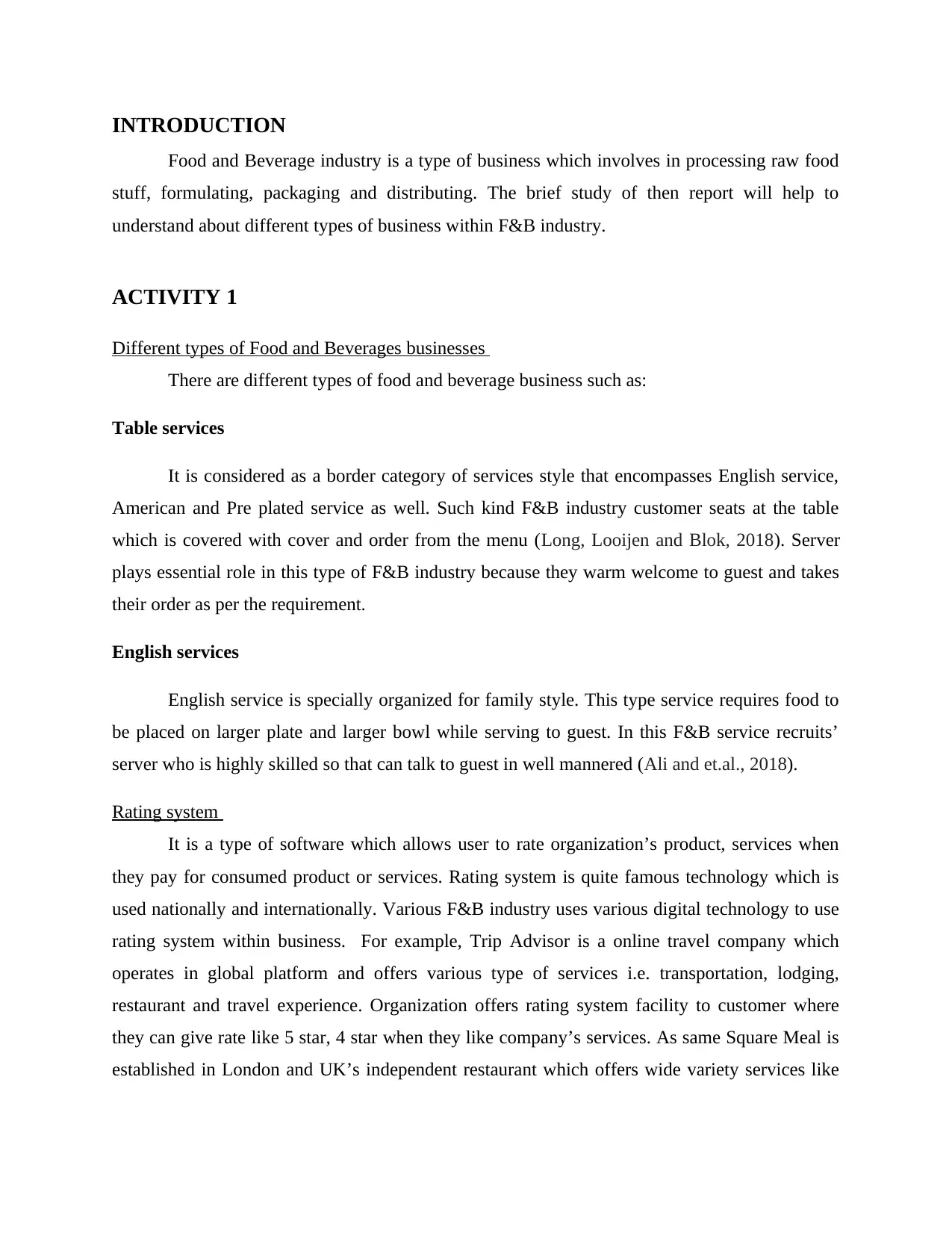
INTRODUCTION
Food and Beverage industry is a type of business which involves in processing raw food
stuff, formulating, packaging and distributing. The brief study of then report will help to
understand about different types of business within F&B industry.
ACTIVITY 1
Different types of Food and Beverages businesses
There are different types of food and beverage business such as:
Table services
It is considered as a border category of services style that encompasses English service,
American and Pre plated service as well. Such kind F&B industry customer seats at the table
which is covered with cover and order from the menu (Long, Looijen and Blok, 2018). Server
plays essential role in this type of F&B industry because they warm welcome to guest and takes
their order as per the requirement.
English services
English service is specially organized for family style. This type service requires food to
be placed on larger plate and larger bowl while serving to guest. In this F&B service recruits’
server who is highly skilled so that can talk to guest in well mannered (Ali and et.al., 2018).
Rating system
It is a type of software which allows user to rate organization’s product, services when
they pay for consumed product or services. Rating system is quite famous technology which is
used nationally and internationally. Various F&B industry uses various digital technology to use
rating system within business. For example, Trip Advisor is a online travel company which
operates in global platform and offers various type of services i.e. transportation, lodging,
restaurant and travel experience. Organization offers rating system facility to customer where
they can give rate like 5 star, 4 star when they like company’s services. As same Square Meal is
established in London and UK’s independent restaurant which offers wide variety services like
Food and Beverage industry is a type of business which involves in processing raw food
stuff, formulating, packaging and distributing. The brief study of then report will help to
understand about different types of business within F&B industry.
ACTIVITY 1
Different types of Food and Beverages businesses
There are different types of food and beverage business such as:
Table services
It is considered as a border category of services style that encompasses English service,
American and Pre plated service as well. Such kind F&B industry customer seats at the table
which is covered with cover and order from the menu (Long, Looijen and Blok, 2018). Server
plays essential role in this type of F&B industry because they warm welcome to guest and takes
their order as per the requirement.
English services
English service is specially organized for family style. This type service requires food to
be placed on larger plate and larger bowl while serving to guest. In this F&B service recruits’
server who is highly skilled so that can talk to guest in well mannered (Ali and et.al., 2018).
Rating system
It is a type of software which allows user to rate organization’s product, services when
they pay for consumed product or services. Rating system is quite famous technology which is
used nationally and internationally. Various F&B industry uses various digital technology to use
rating system within business. For example, Trip Advisor is a online travel company which
operates in global platform and offers various type of services i.e. transportation, lodging,
restaurant and travel experience. Organization offers rating system facility to customer where
they can give rate like 5 star, 4 star when they like company’s services. As same Square Meal is
established in London and UK’s independent restaurant which offers wide variety services like
⊘ This is a preview!⊘
Do you want full access?
Subscribe today to unlock all pages.

Trusted by 1+ million students worldwide
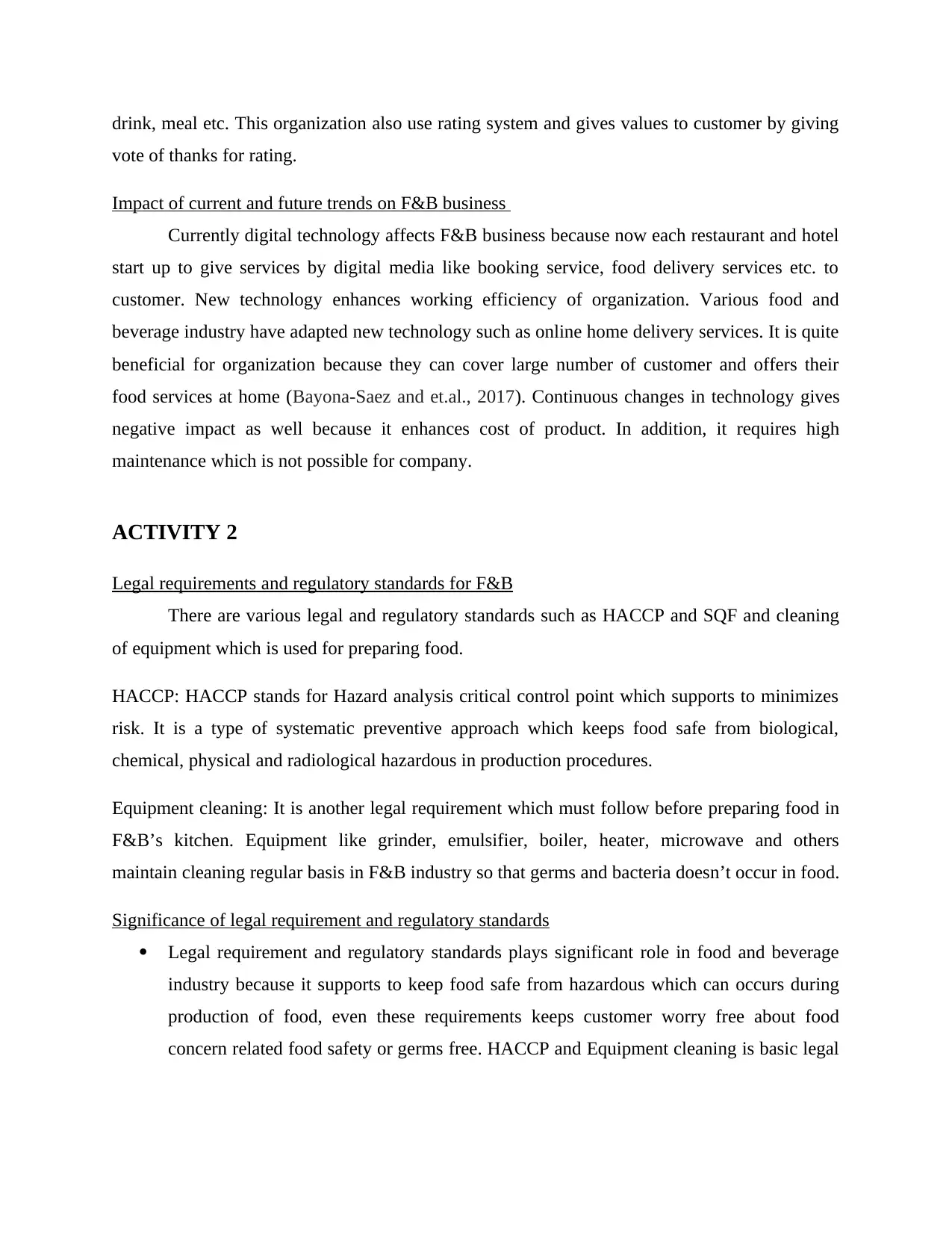
drink, meal etc. This organization also use rating system and gives values to customer by giving
vote of thanks for rating.
Impact of current and future trends on F&B business
Currently digital technology affects F&B business because now each restaurant and hotel
start up to give services by digital media like booking service, food delivery services etc. to
customer. New technology enhances working efficiency of organization. Various food and
beverage industry have adapted new technology such as online home delivery services. It is quite
beneficial for organization because they can cover large number of customer and offers their
food services at home (Bayona-Saez and et.al., 2017). Continuous changes in technology gives
negative impact as well because it enhances cost of product. In addition, it requires high
maintenance which is not possible for company.
ACTIVITY 2
Legal requirements and regulatory standards for F&B
There are various legal and regulatory standards such as HACCP and SQF and cleaning
of equipment which is used for preparing food.
HACCP: HACCP stands for Hazard analysis critical control point which supports to minimizes
risk. It is a type of systematic preventive approach which keeps food safe from biological,
chemical, physical and radiological hazardous in production procedures.
Equipment cleaning: It is another legal requirement which must follow before preparing food in
F&B’s kitchen. Equipment like grinder, emulsifier, boiler, heater, microwave and others
maintain cleaning regular basis in F&B industry so that germs and bacteria doesn’t occur in food.
Significance of legal requirement and regulatory standards
Legal requirement and regulatory standards plays significant role in food and beverage
industry because it supports to keep food safe from hazardous which can occurs during
production of food, even these requirements keeps customer worry free about food
concern related food safety or germs free. HACCP and Equipment cleaning is basic legal
vote of thanks for rating.
Impact of current and future trends on F&B business
Currently digital technology affects F&B business because now each restaurant and hotel
start up to give services by digital media like booking service, food delivery services etc. to
customer. New technology enhances working efficiency of organization. Various food and
beverage industry have adapted new technology such as online home delivery services. It is quite
beneficial for organization because they can cover large number of customer and offers their
food services at home (Bayona-Saez and et.al., 2017). Continuous changes in technology gives
negative impact as well because it enhances cost of product. In addition, it requires high
maintenance which is not possible for company.
ACTIVITY 2
Legal requirements and regulatory standards for F&B
There are various legal and regulatory standards such as HACCP and SQF and cleaning
of equipment which is used for preparing food.
HACCP: HACCP stands for Hazard analysis critical control point which supports to minimizes
risk. It is a type of systematic preventive approach which keeps food safe from biological,
chemical, physical and radiological hazardous in production procedures.
Equipment cleaning: It is another legal requirement which must follow before preparing food in
F&B’s kitchen. Equipment like grinder, emulsifier, boiler, heater, microwave and others
maintain cleaning regular basis in F&B industry so that germs and bacteria doesn’t occur in food.
Significance of legal requirement and regulatory standards
Legal requirement and regulatory standards plays significant role in food and beverage
industry because it supports to keep food safe from hazardous which can occurs during
production of food, even these requirements keeps customer worry free about food
concern related food safety or germs free. HACCP and Equipment cleaning is basic legal
Paraphrase This Document
Need a fresh take? Get an instant paraphrase of this document with our AI Paraphraser
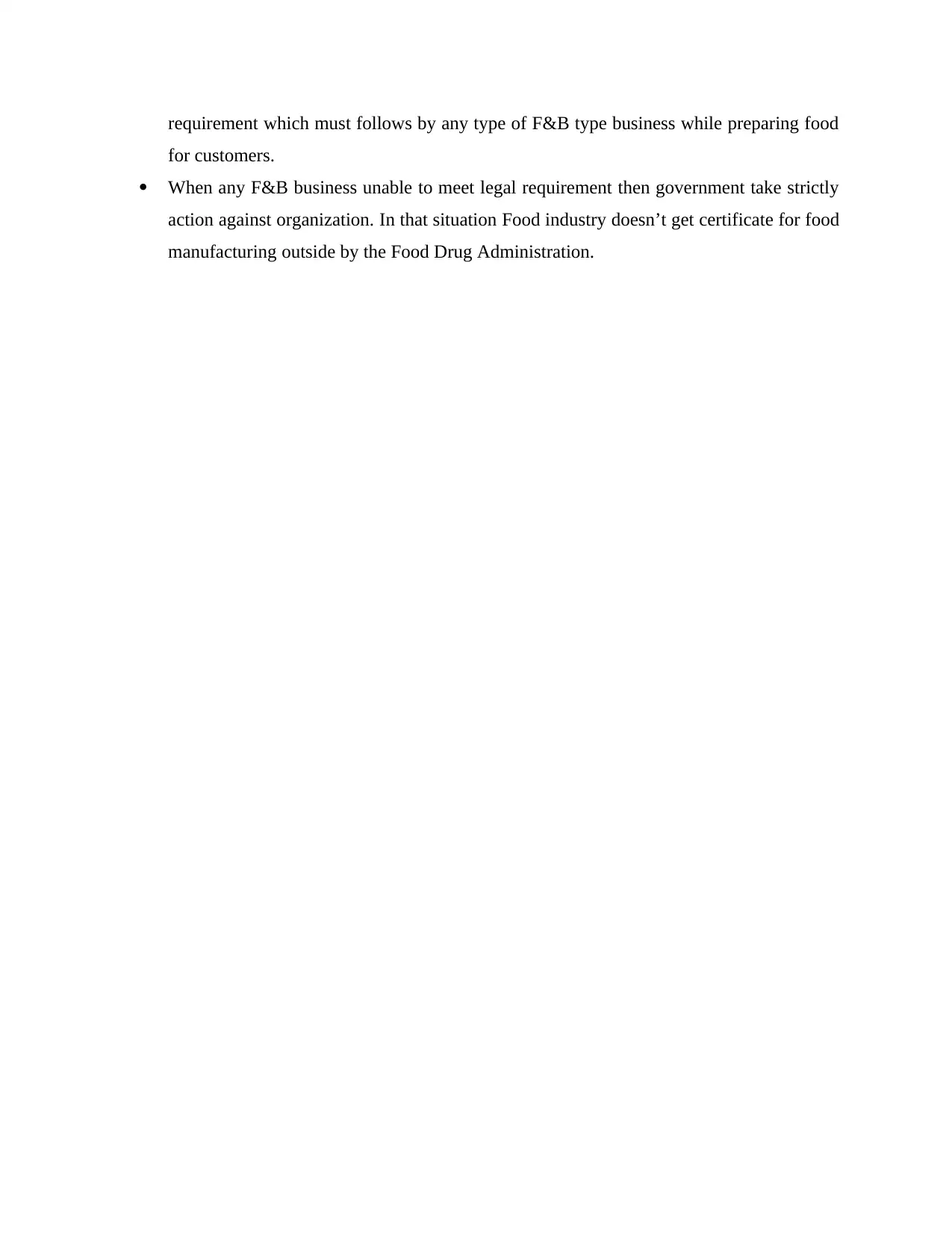
requirement which must follows by any type of F&B type business while preparing food
for customers.
When any F&B business unable to meet legal requirement then government take strictly
action against organization. In that situation Food industry doesn’t get certificate for food
manufacturing outside by the Food Drug Administration.
for customers.
When any F&B business unable to meet legal requirement then government take strictly
action against organization. In that situation Food industry doesn’t get certificate for food
manufacturing outside by the Food Drug Administration.
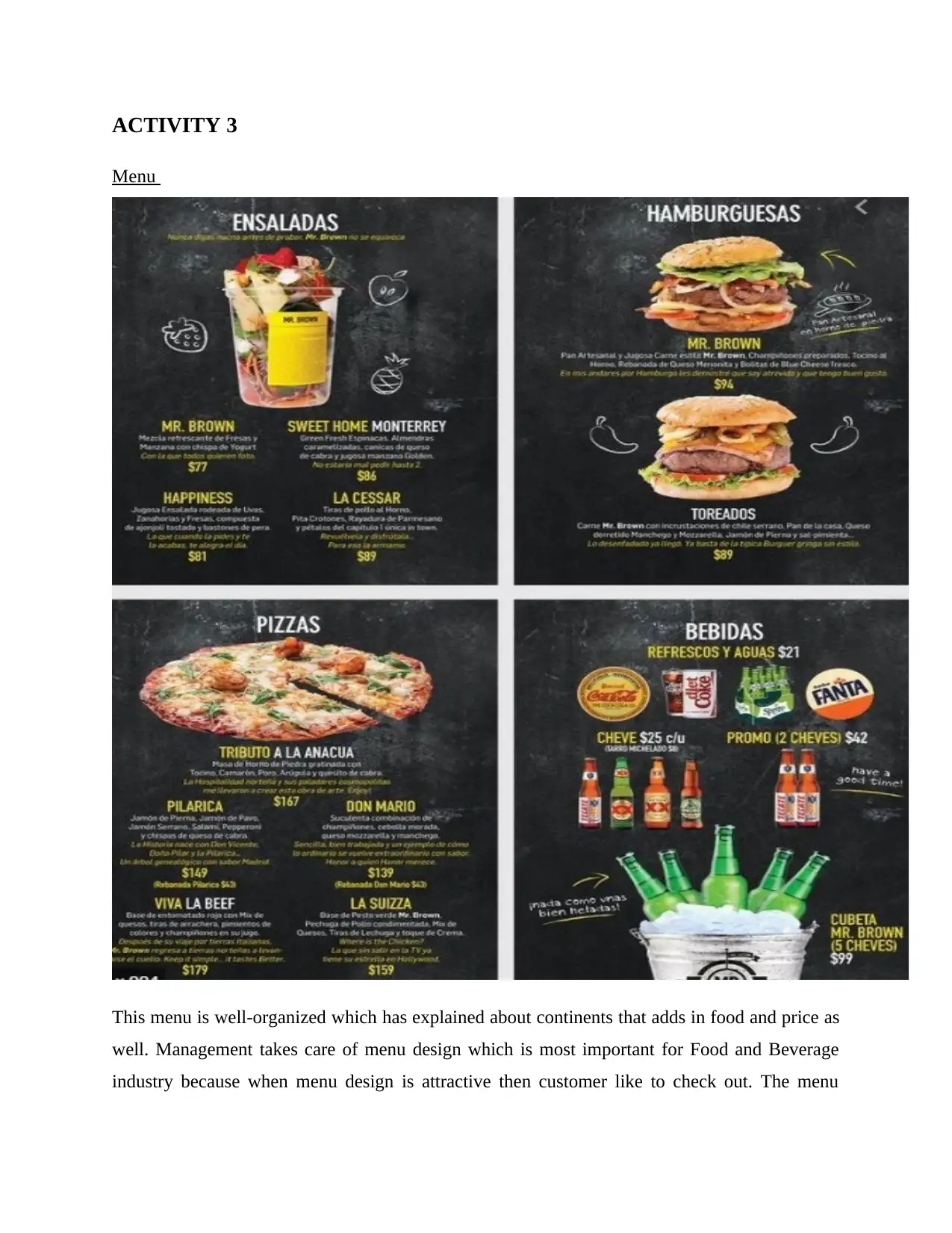
ACTIVITY 3
Menu
This menu is well-organized which has explained about continents that adds in food and price as
well. Management takes care of menu design which is most important for Food and Beverage
industry because when menu design is attractive then customer like to check out. The menu
Menu
This menu is well-organized which has explained about continents that adds in food and price as
well. Management takes care of menu design which is most important for Food and Beverage
industry because when menu design is attractive then customer like to check out. The menu
⊘ This is a preview!⊘
Do you want full access?
Subscribe today to unlock all pages.

Trusted by 1+ million students worldwide
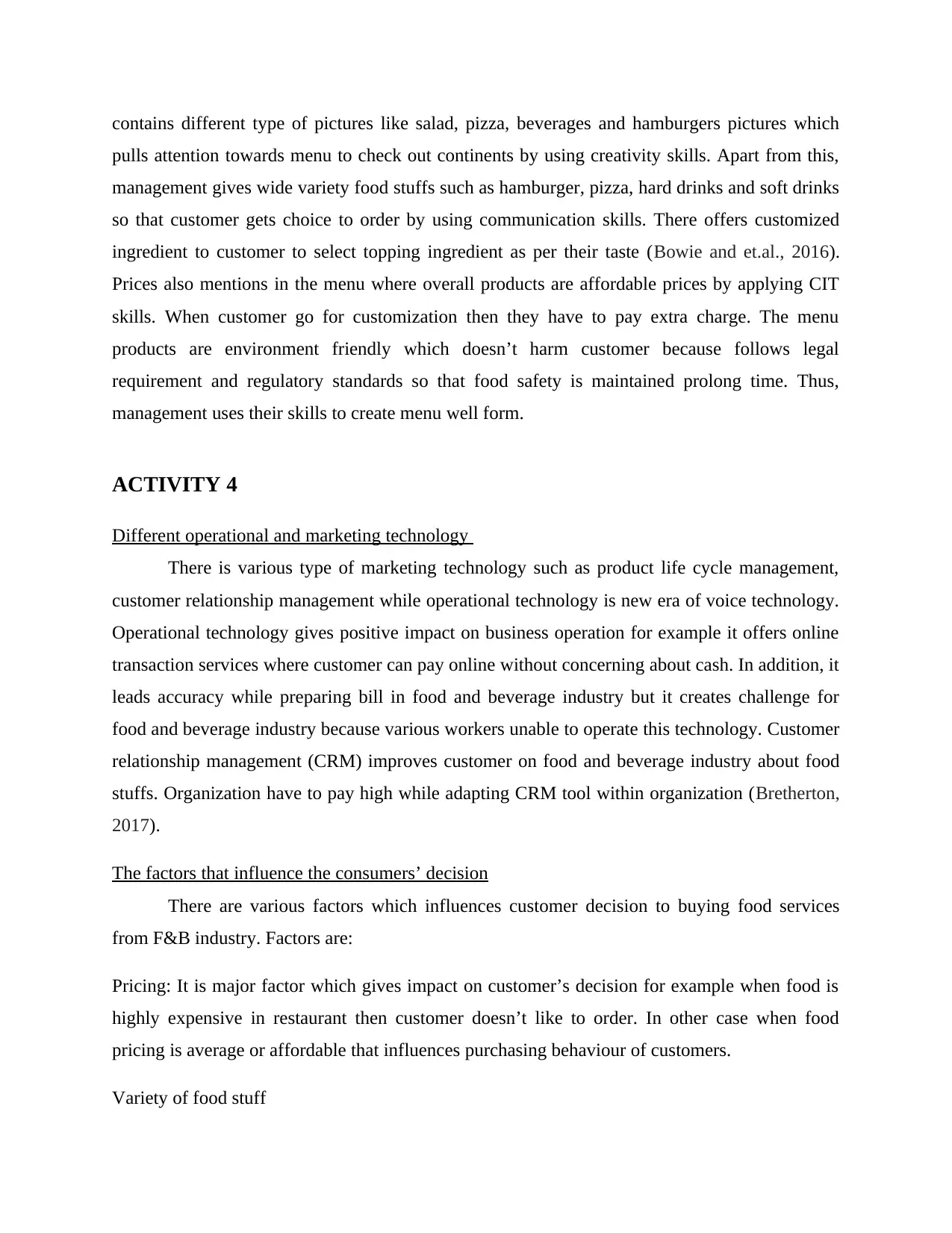
contains different type of pictures like salad, pizza, beverages and hamburgers pictures which
pulls attention towards menu to check out continents by using creativity skills. Apart from this,
management gives wide variety food stuffs such as hamburger, pizza, hard drinks and soft drinks
so that customer gets choice to order by using communication skills. There offers customized
ingredient to customer to select topping ingredient as per their taste (Bowie and et.al., 2016).
Prices also mentions in the menu where overall products are affordable prices by applying CIT
skills. When customer go for customization then they have to pay extra charge. The menu
products are environment friendly which doesn’t harm customer because follows legal
requirement and regulatory standards so that food safety is maintained prolong time. Thus,
management uses their skills to create menu well form.
ACTIVITY 4
Different operational and marketing technology
There is various type of marketing technology such as product life cycle management,
customer relationship management while operational technology is new era of voice technology.
Operational technology gives positive impact on business operation for example it offers online
transaction services where customer can pay online without concerning about cash. In addition, it
leads accuracy while preparing bill in food and beverage industry but it creates challenge for
food and beverage industry because various workers unable to operate this technology. Customer
relationship management (CRM) improves customer on food and beverage industry about food
stuffs. Organization have to pay high while adapting CRM tool within organization (Bretherton,
2017).
The factors that influence the consumers’ decision
There are various factors which influences customer decision to buying food services
from F&B industry. Factors are:
Pricing: It is major factor which gives impact on customer’s decision for example when food is
highly expensive in restaurant then customer doesn’t like to order. In other case when food
pricing is average or affordable that influences purchasing behaviour of customers.
Variety of food stuff
pulls attention towards menu to check out continents by using creativity skills. Apart from this,
management gives wide variety food stuffs such as hamburger, pizza, hard drinks and soft drinks
so that customer gets choice to order by using communication skills. There offers customized
ingredient to customer to select topping ingredient as per their taste (Bowie and et.al., 2016).
Prices also mentions in the menu where overall products are affordable prices by applying CIT
skills. When customer go for customization then they have to pay extra charge. The menu
products are environment friendly which doesn’t harm customer because follows legal
requirement and regulatory standards so that food safety is maintained prolong time. Thus,
management uses their skills to create menu well form.
ACTIVITY 4
Different operational and marketing technology
There is various type of marketing technology such as product life cycle management,
customer relationship management while operational technology is new era of voice technology.
Operational technology gives positive impact on business operation for example it offers online
transaction services where customer can pay online without concerning about cash. In addition, it
leads accuracy while preparing bill in food and beverage industry but it creates challenge for
food and beverage industry because various workers unable to operate this technology. Customer
relationship management (CRM) improves customer on food and beverage industry about food
stuffs. Organization have to pay high while adapting CRM tool within organization (Bretherton,
2017).
The factors that influence the consumers’ decision
There are various factors which influences customer decision to buying food services
from F&B industry. Factors are:
Pricing: It is major factor which gives impact on customer’s decision for example when food is
highly expensive in restaurant then customer doesn’t like to order. In other case when food
pricing is average or affordable that influences purchasing behaviour of customers.
Variety of food stuff
Paraphrase This Document
Need a fresh take? Get an instant paraphrase of this document with our AI Paraphraser
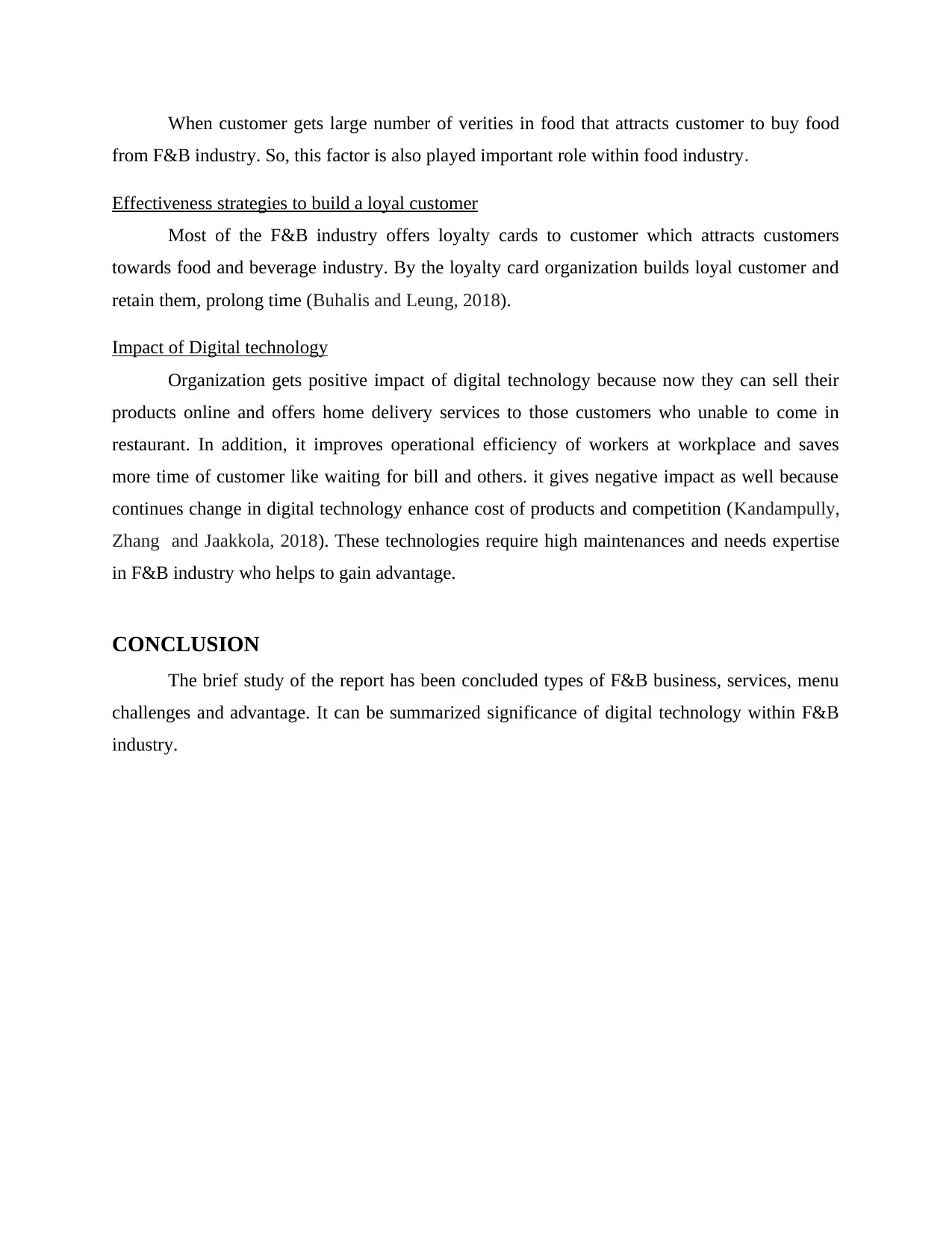
When customer gets large number of verities in food that attracts customer to buy food
from F&B industry. So, this factor is also played important role within food industry.
Effectiveness strategies to build a loyal customer
Most of the F&B industry offers loyalty cards to customer which attracts customers
towards food and beverage industry. By the loyalty card organization builds loyal customer and
retain them, prolong time (Buhalis and Leung, 2018).
Impact of Digital technology
Organization gets positive impact of digital technology because now they can sell their
products online and offers home delivery services to those customers who unable to come in
restaurant. In addition, it improves operational efficiency of workers at workplace and saves
more time of customer like waiting for bill and others. it gives negative impact as well because
continues change in digital technology enhance cost of products and competition (Kandampully,
Zhang and Jaakkola, 2018). These technologies require high maintenances and needs expertise
in F&B industry who helps to gain advantage.
CONCLUSION
The brief study of the report has been concluded types of F&B business, services, menu
challenges and advantage. It can be summarized significance of digital technology within F&B
industry.
from F&B industry. So, this factor is also played important role within food industry.
Effectiveness strategies to build a loyal customer
Most of the F&B industry offers loyalty cards to customer which attracts customers
towards food and beverage industry. By the loyalty card organization builds loyal customer and
retain them, prolong time (Buhalis and Leung, 2018).
Impact of Digital technology
Organization gets positive impact of digital technology because now they can sell their
products online and offers home delivery services to those customers who unable to come in
restaurant. In addition, it improves operational efficiency of workers at workplace and saves
more time of customer like waiting for bill and others. it gives negative impact as well because
continues change in digital technology enhance cost of products and competition (Kandampully,
Zhang and Jaakkola, 2018). These technologies require high maintenances and needs expertise
in F&B industry who helps to gain advantage.
CONCLUSION
The brief study of the report has been concluded types of F&B business, services, menu
challenges and advantage. It can be summarized significance of digital technology within F&B
industry.
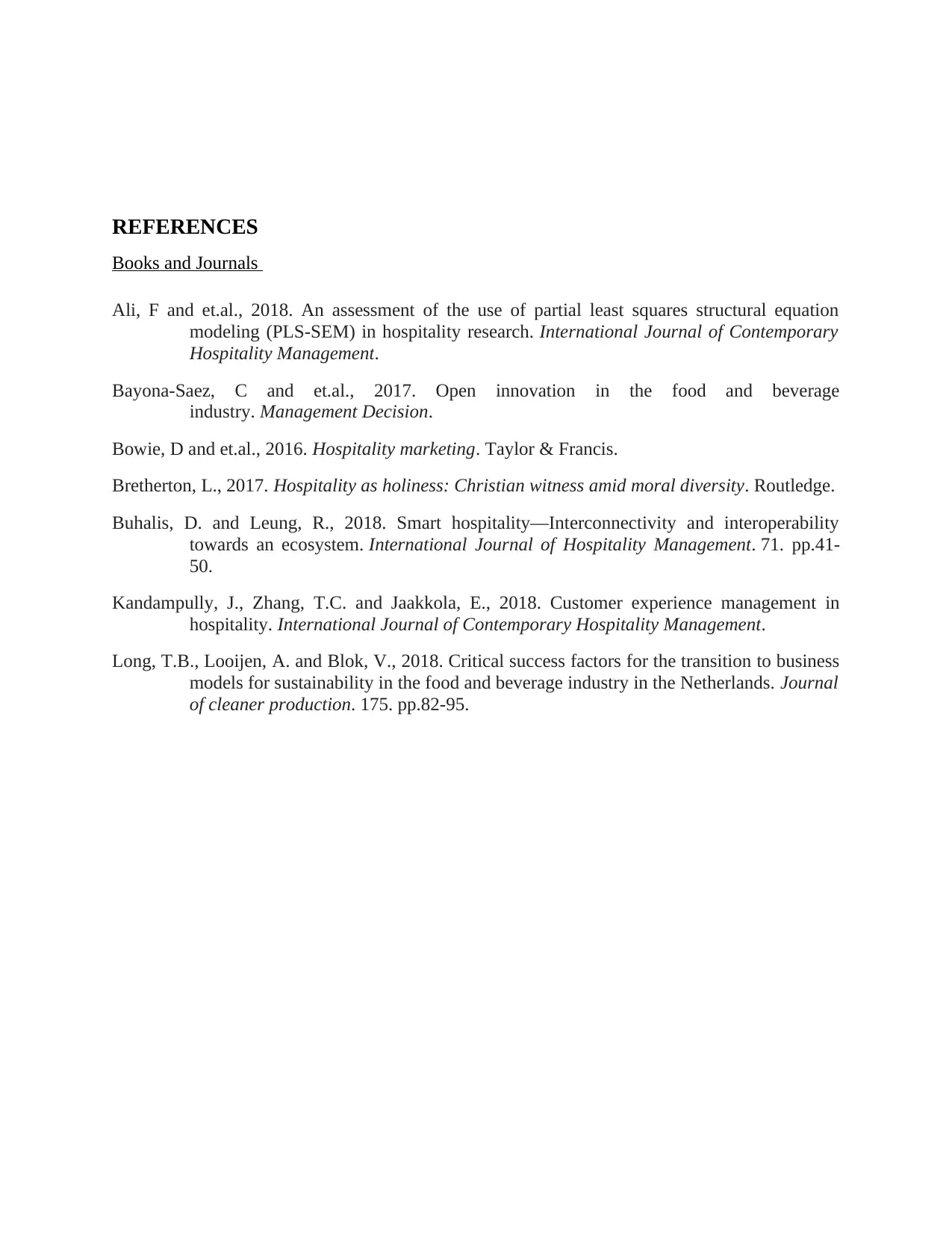
REFERENCES
Books and Journals
Ali, F and et.al., 2018. An assessment of the use of partial least squares structural equation
modeling (PLS-SEM) in hospitality research. International Journal of Contemporary
Hospitality Management.
Bayona-Saez, C and et.al., 2017. Open innovation in the food and beverage
industry. Management Decision.
Bowie, D and et.al., 2016. Hospitality marketing. Taylor & Francis.
Bretherton, L., 2017. Hospitality as holiness: Christian witness amid moral diversity. Routledge.
Buhalis, D. and Leung, R., 2018. Smart hospitality—Interconnectivity and interoperability
towards an ecosystem. International Journal of Hospitality Management. 71. pp.41-
50.
Kandampully, J., Zhang, T.C. and Jaakkola, E., 2018. Customer experience management in
hospitality. International Journal of Contemporary Hospitality Management.
Long, T.B., Looijen, A. and Blok, V., 2018. Critical success factors for the transition to business
models for sustainability in the food and beverage industry in the Netherlands. Journal
of cleaner production. 175. pp.82-95.
Books and Journals
Ali, F and et.al., 2018. An assessment of the use of partial least squares structural equation
modeling (PLS-SEM) in hospitality research. International Journal of Contemporary
Hospitality Management.
Bayona-Saez, C and et.al., 2017. Open innovation in the food and beverage
industry. Management Decision.
Bowie, D and et.al., 2016. Hospitality marketing. Taylor & Francis.
Bretherton, L., 2017. Hospitality as holiness: Christian witness amid moral diversity. Routledge.
Buhalis, D. and Leung, R., 2018. Smart hospitality—Interconnectivity and interoperability
towards an ecosystem. International Journal of Hospitality Management. 71. pp.41-
50.
Kandampully, J., Zhang, T.C. and Jaakkola, E., 2018. Customer experience management in
hospitality. International Journal of Contemporary Hospitality Management.
Long, T.B., Looijen, A. and Blok, V., 2018. Critical success factors for the transition to business
models for sustainability in the food and beverage industry in the Netherlands. Journal
of cleaner production. 175. pp.82-95.
⊘ This is a preview!⊘
Do you want full access?
Subscribe today to unlock all pages.

Trusted by 1+ million students worldwide
1 out of 9
Related Documents
Your All-in-One AI-Powered Toolkit for Academic Success.
+13062052269
info@desklib.com
Available 24*7 on WhatsApp / Email
![[object Object]](/_next/static/media/star-bottom.7253800d.svg)
Unlock your academic potential
Copyright © 2020–2025 A2Z Services. All Rights Reserved. Developed and managed by ZUCOL.





